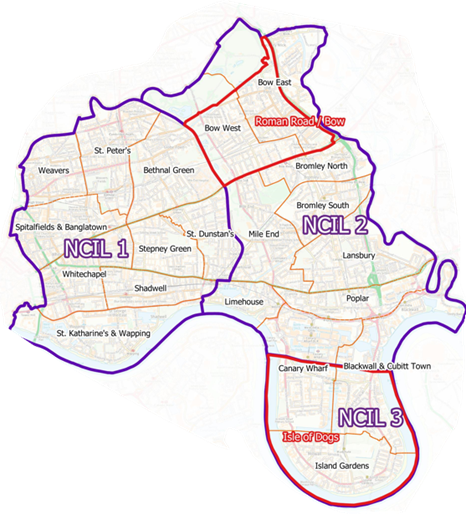Neighbourhood Community Infrastructure Levy (NCIL)
What is the Neighbourhood Community Infrastructure Levy (NCIL)?
The Neighbourhood Community Infrastructure Levy (NCIL), is a portion of the Community Infrastructure Levy that is collected by a charging authority. It may be spent to address the demands that development places on a local area.
NCIL may be spent on both infrastructure and non-infrastructure items. The regulations established the “meaningful proportion’’ for the Neighbourhood element, as being:
- 15% for areas without an adopted Neighbourhood Plan and
- 25% for areas with an adopted Neighbourhood Plan.
The national Planning Practice Guidance (PPG) sets out how the government expects local authorities to approach the spending of the neighbourhood portion. The guidance states that the local authority should consult with the community, on how best to spend the NCIL collected from developments. The use of neighbourhood funds should match priorities expressed by local communities, including priorities set out formally in neighbourhood plans. The PPG sets out that local authorities should also consider the infrastructure needs of the wider area.
Delivery Framework
On 21 June 2023, a new delivery framework was approved by the Mayor in Cabinet in respect of how NCIL should be invested in the borough.
The agreed approach for NCIL funding is the 3 sub-programmes. These are in order of priority and dependent on the amount of NCIL collected for the year:
- Community Grants Programme – a portion of NCIL will be ring-fenced for the ‘grants programme pot’ to fund community projects that align with the requirements of NCIL funding. The grants programme pot aims to put control in the hands of local people. This ensures that the whole community will benefit from the delivery of new development. See more information about the Mayors Community grants Programme.
- Capital Projects – NCIL funding will be ring-fenced to deliver local infrastructure projects that match the local communities’ priorities. These will be identified for each neighbourhood area through the Annual Residents Survey and where relevant, any adopted Neighbourhood Plan.
The selection of suitable capital projects will be through the Council’s existing Capital Programme governance process and approved by the Mayor in Cabinet.
- Affordable Housing Projects – NCIL funding will be ring-fenced for the delivery of affordable housing projects in the capital programme. This is to ensure that development delivers for all local people and supports the Councils ambition to deliver 4,000 affordable homes. These will be selected and formalised through the Council’s existing Capital Programme governance process and approved by the Mayor in Cabinet.
For information on the Council’s previous approach to NCIL please see the Local Infrastructure Fund (LIF).
Neighbourhood areas
The borough has been split into 3 neighbourhood areas for the purposes of collecting and spending NCIL:
- NCIL area 1:
- Bethnal Green
- Weavers
- Whitechapel
- Shadwell
- Spitalfields and Banglatown
- Stepney Green
- St Dunstan's
- St Katherine's and Wapping
- St Peter's
- NCIL area 2:
- Bromley North
- Bromley South
- Lansbury
- Limehouse
- Mile End
- Poplar
- Bow East
- Bow West
- Canary Wharf (Part)
- Blackwall and Cubitt Town (Part)
- NCIL area 3:
- Canary Wharf (Part)
- Blackwall and Cubitt Town (Part)
- Island Gardens
Areas with adopted neighbourhood plans
All NCIL neighbourhood areas will benefit from 15% of CIL collected in that area, except for areas that have an adopted neighbourhood plan that will benefit from 25%. There are 2 adopted Neighbourhood Plans:
- Isle of Dogs
- Roman Road / Bow

Local engagement
The council’s engagement approach will be to directly engage with neighbourhoods through the grants process. This will put the delivery of improvements into the hands of local people. We will also use the Annual resident surveys (ARS) and existing networks to identify local community priorities on infrastructure spending. The ARS has the advantage of being based on statistically representative sampling. The identified priorities will be used to inform the capital projects allocations using neighbourhood level statistics. This will make sure local priorities are addressed.
London Legacy Development Corporation
On Sunday 1 December 2024, the London Legacy Development Corporation’s (LLDC) planning powers for the Tower Hamlets area (in Hackney Wick and Bow) were returned to the London Borough of Tower Hamlets.
The LLDC historically collected the Community Infrastructure Levy (CIL) within its area. It ring fenced 15 per cent of these receipts as Neighbourhood CIL (NCIL) to be spent in consultation with local communities.
The LLDC managed their NCIL through the Neighbourhood Priorities Fund (NPF) that enabled local communities to bid for funding for projects.
Tower Hamlets is now responsible for monitoring any ongoing projects. Any unallocated NCIL will be added to Tower Hamlets Neighbourhood CIL (NCIL) funding pot and spent in accordance with the council’s adopted approach to NCIL.
Contact
If you have any questions, please email NCIL@towerhamlets.gov.uk